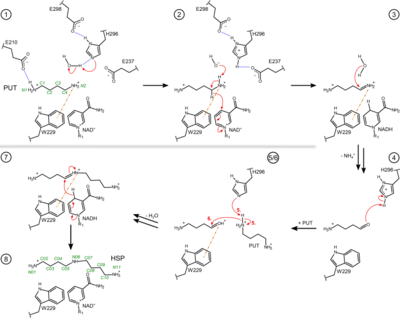Journal:Acta Cryst F:S2053230X21013455
From Proteopedia

Crystal structure of betaine aldehyde dehydrogenase from Burkholderia pseudomalleiDylan K. Beard, Sandhya Subramanian, Jan Abendroth, Thomas E. Edwards, Peter J. Myler, and Oluwatoyin A. Asojo [1] Molecular Tour
BpBADH has a prototypical BADH topology and shares considerable structure and sequence similarity with the ortholog from P. aeruginosa (PaBADH); see static image below:  Figure 3. Proposed reaction steps of the conversion of PUT to HSP by the bacterial HSS. Relevant residues, NAD(H), PUT, HSP and intermediates are shown as two-dimensional structure representations. Hydrogen bonds are depicted as blue dotted lines, delocalized electrons as dashed lines, cation-π interactions as orange dash-dotted lines and electron transfers as red arrows. Atom numbering is given for PUT and HSP in green. For simplicity, steps 5 and 6 are shown in combined depictions with correspondingly labeled electron transfers. A more detailed sequence of reaction steps was described before[2] and additional intervening reaction steps are proposed in Fig. S2 of Helfrich & Scheidig, 2021[3]. The structures are similar to those of BADH from Pseudomonas aeruginosa (PaBADH). The co-factor binding domains of BpBADH (6wsb) and PaBADH (4caz) are well conserved (identical residues of both structures are labeled in green, while non-identical in red): PaBADH is inhibited by the drug disulfiram which is an approved drug. Both structures show the irreversibly inhibited by disulfiram. Our preliminary analysis could facilitate drug repurposing studies for melioidosis. This project is an educational collaboration between the SSGCID and Hampton University. The SSGCID consortium is directed by Dr. Peter Myler (principal investigator) and comprises many different scientists working at multiple centers towards determining the three-dimensional structures of proteins from biodefense organisms and emerging infectious diseases. Dylan K. Beard was part of a pilot Hampton University Chemistry Education and Mentorship Course-based undergraduate research (HU-ChEM CURES) funded by the NIGMS. References
| |||||||||||
